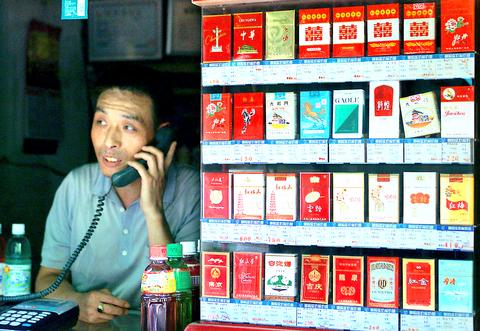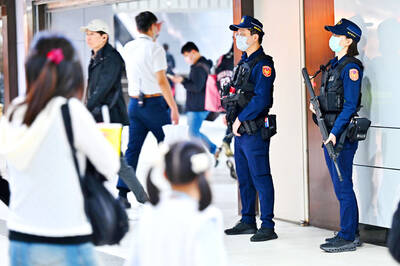With names ranging from Red Double Happiness to Weige (Chinese for Viagra) and Lesser Panda, Chinese-made cigarettes of every hue and shape crowd the shelves of shops in a country of more than 300 million smokers.
One in four of these packs of cigarettes comes from fields of long tobacco leaves that sway in the summer breeze throughout the southwestern province of Yunnan.

PHOTO: REUTERS
But clouds are forming over China's tobacco country.
Foreign brands like 555 made by British American Tobacco and Mild Seven by Japan Tobacco Inc are poised to dethrone homegrown favorites once China joins the WTO, expected by early next year at the latest.
While the race to win the fickle hearts of Chinese smokers isn't over by any means, domestic tobacco giants including China's largest cigarette maker Yunnan Hongta Group have already begun to fret over foreign competition.
With packs of the the company's flagship brands like Red Pagoda and Happy New Year resting before him on a red lacquered table, Zhu Xiaoyang, director and vice-president of Hongta eyes the future nervously.
"We will see new competitors in the market after China enters the WTO and there will be changes in the industry," Zhu said at Hongta's headquarters in the Yunnan city of Yuxi.
Nowhere in China has more at stake in the looming battle than Yunnan. Its 2.47 million tonnes of tobacco accounts for a quarter of China's output and is home to Kunming Cigarette Factory, Qujing Cigarette Factory and giant Hongta.
Virtually everyone in and around Yuxi is involved in the cigarette industry -- from growers in straw hats to factory workers.
But heavily taxed foreign cigarettes have already built a strong following in China, especially in the cities.
"I have been smoking Sanwu (555 in Mandarin) for seven years because I like the taste and I have less phlegm than when I smoke some Chinese brands," says lanky Shanghai taxi driver Jin Jianxin.
Once China enters the WTO, tariffs on tobacco leaves will be slashed to 10 percent from 40 percent by 2004 and on cigarettes to 25 percent from 36 percent.
Foreign cigarette makers like BAT and Philip Morris, which exports its Marlboro brand to China, are poised to make inroads into the world's largest cigarette market the moment rules are relaxed on joint ventures after WTO membership.
Now, only a handful of brands like Camel and Winston are made in China. Philip Morris is ready to join the fray with an agreement to produce cigarettes in Tianjin, according to a recent US Department of Agriculture report.
BAT said in May it was in talks with the Chinese government about setting up a joint venture in Sichuan Province.
Japan Tobacco has been making Mild Seven and Mild Seven Lights since March 2000 in bonded areas in China, which are still subject to import tariffs.
Officials at Philip Morris, British American Tobacco and Japan Tobacco declined to comment on future plans. Their silence only makes Chinese tobacco firms more nervous.
Cigarette makers like Hongta are hoping their roasted homegrown tobacco and special blends of flavorings will keep domestic smokers from running after the Marlboro Man.
"Our roasted cigarettes have fewer additives. The way we make cigarettes is like brewing claypot chicken. We try to retain the original flavor, though we would still need to add some seasoning like salt, MSG and ginger," said Zhu.
But with the tastes of China's younger generation leaning towards Western blends, Chinese cigarette makers may have to sprinkle more foreign leaves into their recipe.
"Chinese companies are going to require some time to learn how to handle blends," says one Western diplomat in Beijing. "The present way that China does is straight unblended flux cigarette which is very harsh."
Some cigarette makers are trying to change this, by using South American tobacco in their mixes.
China said in March it would allow imports of US tobacco after barring it in 1989 due to blue mould concerns, handing domestic firms another choice of foreign tobacco.
But Hongta has second thoughts about US tobacco because it costs several times more than other imported leaves.
"As far as imports are concerned, Zimbabwe, Malawi and Brazil have their own unique flavor. US tobacco leaves are also very good, but they are very expensive," says Zhu.
Rising tobacco imports are likely to displace some domestic leaves, but, say industry analysts, may give Chinese cigarettes a better chance to sell overseas. At present, very little was exported.
China, meanwhile, is discouraging development of the tobacco industry -- often described as a sector on the decline. This year, it plans to reduce tobacco acreage by 28,000 hectares to 948,600 hectares, state media said last month.
With more smokers than there are Americans, China faces grim health problems. A 1999 report by US and Chinese researchers said 50 million Chinese smokers are expected to die prematurely.
"The Chinese government is starting to pursue the health concern issue and my suspicion is the percentage of the population smoking is not going to rise much," the Western diplomat said.

TRAGEDY STRIKES TAIPEI: The suspect died after falling off a building after he threw smoke grenades into Taipei Main Station and went on a killing spree in Zhongshan A 27-year-old suspect allegedly threw smoke grenades in Taipei Main Station and then proceeded to Zhongshan MRT Station in a random killing spree that resulted in the death of the suspect and two other civilians, and seven injured, including one in critical condition, as of press time last night. The suspect, identified as a man surnamed Chang Wen (張文), allegedly began the attack at Taipei Main Station, the Taipei Fire Department said, adding that it received a report at 5:24pm that smoke grenades had been thrown in the station. One man in his 50s was rushed to hospital after a cardiac arrest

SAFETY FIRST: Double the number of police were deployed at the Taipei Marathon, while other cities released plans to bolster public event safety Authorities across Taiwan have stepped up security measures ahead of Christmas and New Year events, following a knife and smoke bomb attack in Taipei on Friday that left four people dead and 11 injured. In a bid to prevent potential copycat incidents, police deployments have been expanded for large gatherings, transport hubs, and other crowded public spaces, according to official statements from police and city authorities. Taipei Mayor Chiang Wan-an (蔣萬安) said the city has “comprehensively raised security readiness” in crowded areas, increased police deployments with armed officers, and intensified patrols during weekends and nighttime hours. For large-scale events, security checkpoints and explosives

A car bomb killed a senior Russian general in southern Moscow yesterday morning, the latest high-profile army figure to be blown up in a blast that came just hours after Russian and Ukrainian delegates held separate talks in Miami on a plan to end the war. Kyiv has not commented on the incident, but Russian investigators said they were probing whether the blast was “linked” to “Ukrainian special forces.” The attack was similar to other assassinations of generals and pro-war figures that have either been claimed, or are widely believed to have been orchestrated, by Ukraine. Russian Lieutenant General Fanil Sarvarov, 56, head

PUBLIC SAFETY: The premier said that security would be tightened in transport hubs, while President Lai commended the public for their bravery The government is to deploy more police, including rapid response units, in crowded public areas to ensure a swift response to any threats, President William Lai (賴清德) said yesterday after a knife attack killed three people and injured 11 in Taipei the previous day. Lai made the remarks following a briefing by the National Police Agency on the progress of the investigation, saying that the attack underscored the importance of cooperation in public security between the central and local governments. The attack unfolded in the early evening on Friday around Taipei Main Station’s M7 exit and later near the Taipei MRT’s Zhongshan